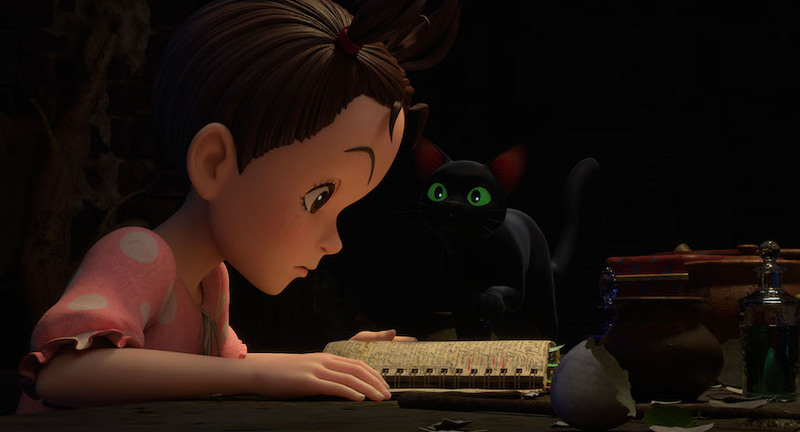EARWIG AND THE WITCH Interview: Miyazaki Gorô On Helming Studio Ghibli's CGI Debut

As the years went by, the influential Studio Ghibli didn’t seem interested in using computer animation, which had its first big movie success, Toy Story, more than a quarter of century ago. Their most recent work, Earwig and the Witch, finally marks Studio Ghibli’s debut in this type of production that Hollywood, by the hand of Pixar, made the norm.
“Miyazaki Hayao and Takahata Isao [Studio Ghibli founders] didn’t feel that CGI was a necessary tool to use in creating their vision,” revealed Miyazaki Gorô, Hayao's son and the director of Earwig and the Witch, “here in Japan hand-drawn animation is still very strong but if you look at what’s happening globally, there’s a lot of different CG animation being made. Myself and the producer felt that it was a good time to challenge ourselves to something new and go into the world of CGI.”
Earwig and the Witch, based on Diana Wynne Jones’ novel, stars Erica Wigg –or Earwig–, a girl who lives in an English orphanage. She was brought to the place as a baby by a red-haired woman, who was being chased by her fellow witches. In the present, Erica is happy in the institution, she’s characterized by her leadership and being somewhat manipulative, she loves shepherd’s pie and, curiously, she does her best to avoid being adopted.
The situation changes when a couple of strange characters –the witch Bella Yaga and the demon Mandrake– choose the protagonist regardless of her displeasure. Hard work awaits Erica as the witch's assistant, as well as disappointment: she would rather learn magic than just collect and prepare the ingredients for the enchantments. Eventually, with the help of a talking black cat named Thomas, Erica tries to craft ambitious spells that allow her to get ahead of the witch.
Fantastic elements are recurring in the worlds of Ghibli. For Gorô, “having witches and using magic in a story is very convenient in a way that you’re able to tell an interesting story that’s both very compelling story-wise and also visual-wise, because you’re able to do anything if you explain that’s because magic. There’s a lot of wit, it makes the storytelling much broader in a sense. But at the same time you have to be careful not to use it too much or else it would just look cheap. With Kiki’s Delivery Service we limited the magic to that she can fly on a broomstick. This time around we also made sure that we don’t rely too much on the magic.”
Earwig and the Witch portrays a period of growth and adaptation for Erica, it’s certainly a coming-of-age story, which connects it with the other two feature films by Miyazaki Gorô: Tales from Earthsea and From Up on Poppy Hill. According to the filmmaker, “telling the story of someone’s growth, rather than writing a story about somebody who’s perfect or already achieved something, allows to see the possibilities that lie in the future. In order to show that there’s immense hope, it’s necessary to tell the story of growth. It also relates to the fact that, traditionally, animation started off as something that was targeted to children, so there’s a storytelling element of telling a story to a children there.”
In Earwig and the Witch there’s a mysterious background: a rock band, called Earwig, connects the past of the protagonist –and the red-haired woman– with her present. “When I read the original story, it says that Earwig’s mother is being chased by the witches because she made them angry,” Gorô recalled, “I was imagining how in the witch world there are certain rules or traditions, and probably the mother broke the rule and that’s why she’s being chased. I imagined that the mother might be someone really rebellious and then what symbolizes rebellion is rock music. So witches forming a rock a band isn’t something that you would imagine. I thought it would be very fun and interesting to do that. I always thought about actually evoke emotions through the story. But music supports film in a lot of ways, it can make the audience feel emotion if you do it in the right way.”
Although the legendary Miyazaki Hayao appears in the credits of Earwig and the Witch as planner of the project, the reality is that his interference was practically nil. “The focus was on how do I avoid him interfering?,” Gorô explained with a laugh, “when we’re doing hand-drawn animation he would give advice and suggestions to the animators. This time around, because we were doing 3D CG, he probably didn’t understand what we were doing anyway, so it was a good thing to keep him away from us. That gave us a free rein to do what we wanted to do.”
Gorô Miyazaki also directed the first Ghibli television series (Ronja, the Robber’s Daughter), therefore he considered that in the studio they “challenge me with new things on purpose, to see whether it works. I’m kind of like the sacrificed here.[laughs].” Once he took on the major challenge of venturing into the uncharted territory of CGI, he noted that “it was more work compared to hand-drawn animation. You have to go through the check process a lot more, with computers you’re basically checking each small movement on the screen, you have to check the same sequence and the cut over and over again. It was really tiring to the eyes.”
Gorô and Ghibli were realistic about their scope: “Pixar in CG animation is like Tesla when it comes to electric vehicles. What we are doing here is more like bicycles with batteries. There’s such a wide gap.”
Earwig and the Witch was released in the United States this week –in select theaters and on HBO Max–, with the intention of standing out in the upcoming awards season.







